1. Unique Cat Drawing Ideas
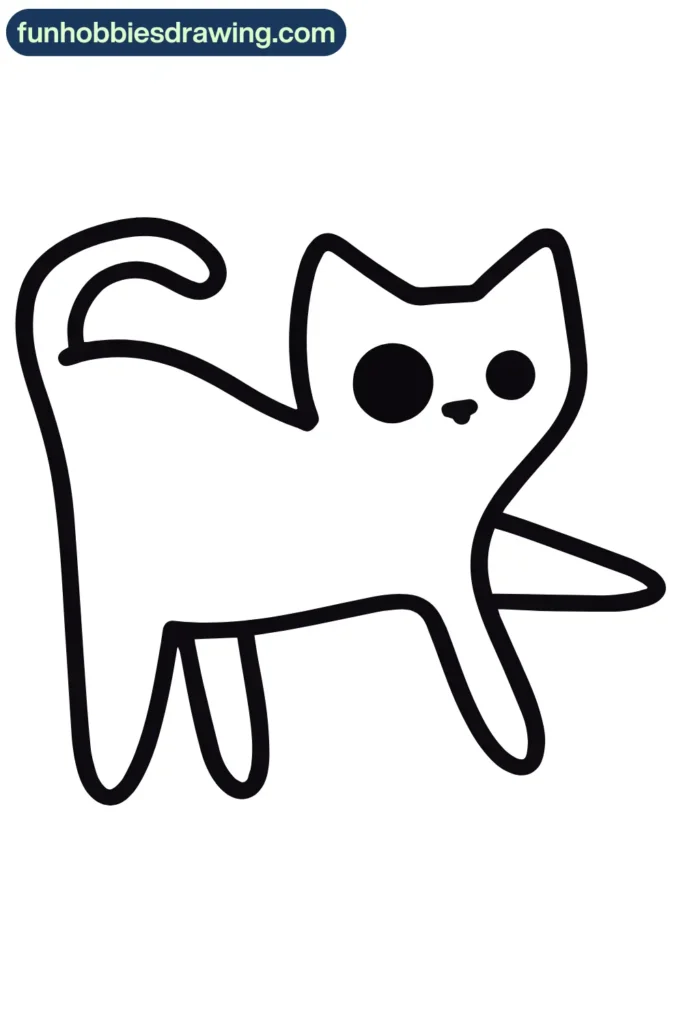
Cats are fascinating subjects for drawing, with their sleek looks, varied patterns, and lively expressions. As an artist, trying new cat drawing ideas can make your feline art stand out. This section aims to spark your creativity, whether you’re just starting or have lots of experience.
From playful kittens to regal tabbies, cats offer endless artistic options. Try different materials, like soft pencils for fur or bold pastels for bright colors. Show the true spirit of your feline subjects with creative poses, unique views, or imaginative settings.
When drawing cats, observing them closely is essential. Look at their detailed features, like their eyes and body shapes. Add these details to your sketches to make your cat drawings come alive and show their true character.
Let your creativity shine with these unique cat drawing ideas. Let your imagination run wild and bring your feline art to life. With practice and trying new things, you’ll learn more about cat anatomy and improve your skills. Soon, you’ll be creating amazing cat drawing ideas, cute cat sketches, and feline illustration tutorials.
2. Basic Cat Drawing Ideas
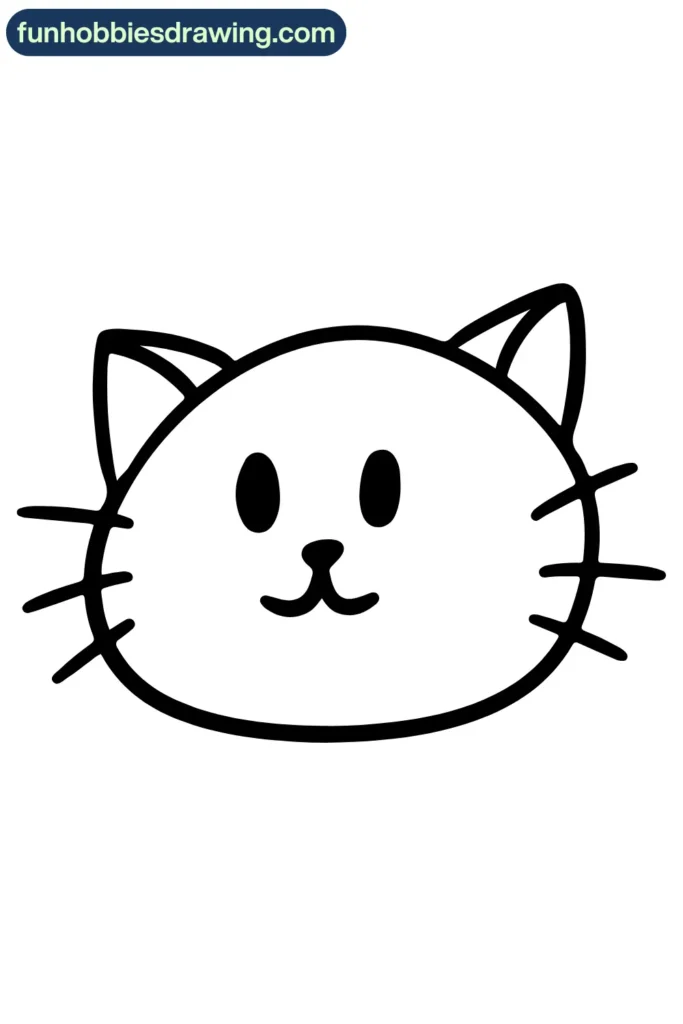
Learning to draw a cat starts with the basics. This guide will show you how to draw a cat step by step. You’ll learn about basic shapes and how to capture a cat’s unique features. These basics will help you move on to more advanced techniques with confidence.
First, get your art supplies ready. You’ll need a pencil (soft 2B or higher), an eraser, paper or a sketchbook, and colored pencils or markers if you like. Now, let’s start drawing a cat.
Begin with a light circle or oval for the cat’s head. Then, add the eyes, nose, and mouth, making sure they’re in the right place. Focus on the angles and positions to get the cat’s essence right.
After the head and face are done, draw the body with elongated shapes. Make sure the body is in proportion to the head. Include the legs and paws, focusing on their angles and lengths.
Now, add fur texture, whiskers, and details. Use short, curved lines for fur texture. Shade to add depth and consider highlights for a realistic look.
Remember, practice and patience are key. Enjoy the process, try new things, and let your creativity flow. With this guide, you’re ready to master the basics of cat drawing and explore your artistic side.
3. Watercolor Cat Drawing Ideas
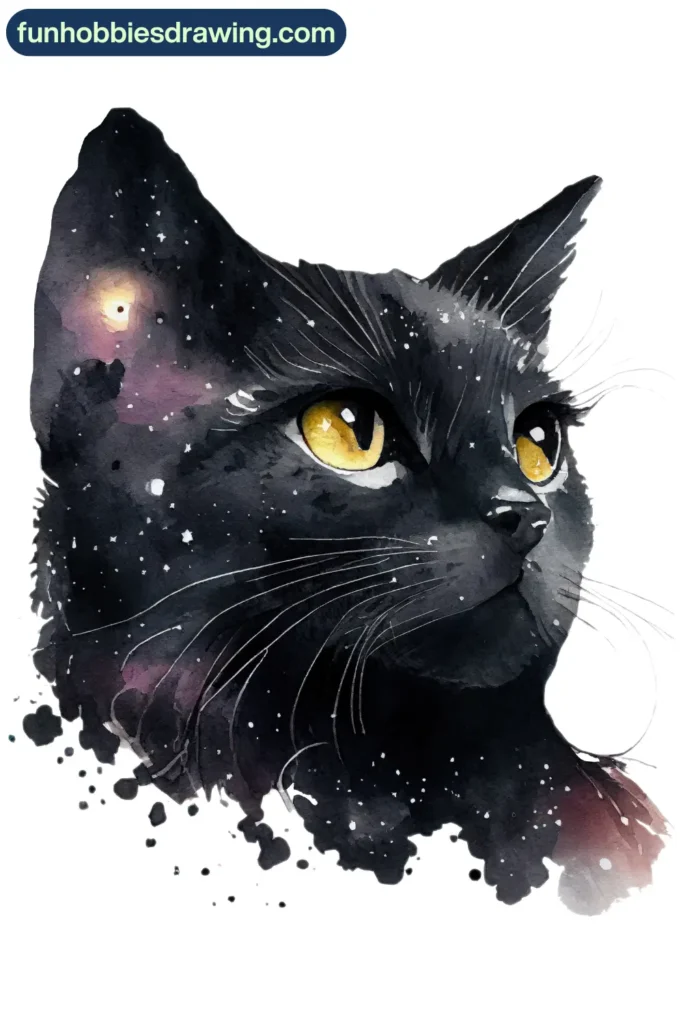
Cats offer endless possibilities for art. As an artist, I encourage you to explore unique cat drawing ideas. You can create abstract pieces or whimsical character designs, capturing the essence of these fascinating felines.
One of my favorite creative cat sketches is playing with proportions. Try drawing a cat with a huge head or oversized paws for a playful look. Or, use bold, expressive brushstrokes and vibrant colors to show the cat’s energy and personality.
Don’t be afraid to break free from traditional realism. Let your imagination run wild with stylized patterns, geometric shapes, or surreal compositions. The goal is to have fun and create something unique and captivating.
The beauty of cat drawing ideas is in their diversity. You can choose a realistic style or go for something completely abstract. The journey of bringing these feline subjects to life is both challenging and rewarding. Let your feline art inspiration shine through in every stroke.
4. Cat Illustration Drawing

If you’re new to drawing cats, don’t worry! This section has beginner-friendly tutorials for you. You’ll learn to draw simple lines and colorful cats step by step. Soon, you’ll be creating adorable cat sketches.
The “Psychedelic Cat Drawing” by Heather Nesheim is a great place to start. It teaches you to draw a cat with a cool, abstract design. You’ll use pencils, fineliners, and Copic markers. The MOLOTOW fineliners help with precise lines, and you can buy supplies through an Amazon affiliate link.
The “Gridded Cat Face” tutorial is another must-try. It shows how to draw a cat’s face accurately. By using a grid, even beginners can create a beautiful cat portrait. You’ll learn about drawing the head, ears, eyes, nose, mouth, and fur.
For a hands-on experience, check out the Awesome Art School’s live drawing sessions. Here, you can draw your own cat illustrations in real-time. Join the community and have fun with these engaging tutorials.
5. Outdoor Cat Drawing
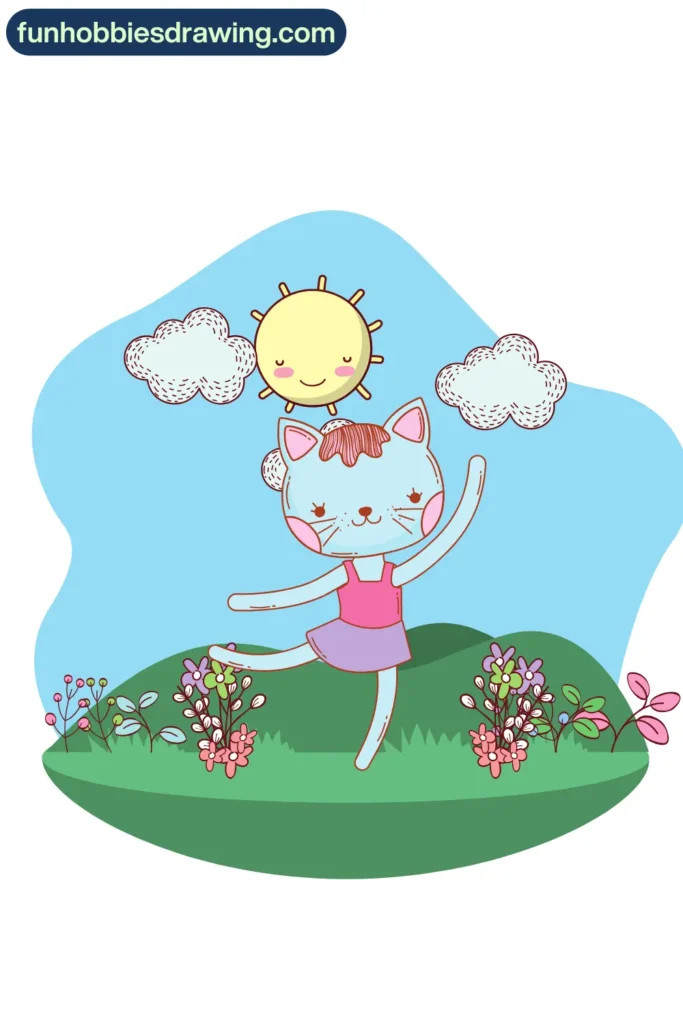
Exploring mixed media can make your cat drawings come alive. By mixing different art materials, you open up a world of creativity. You can create unique feline-inspired art. Watercolor’s soft strokes and acrylic paint’s bright colors can take your cat drawings to new levels.
Start with a pencil sketch and add watercolor washes for depth. The mix of watercolor and pencil lines creates a stunning effect. Or, try collaging textures like fabric or paper for a tactile and eye-catching cat portrait.
Acrylic paints can add a bold, vibrant touch to your cat drawings. Their opaque quality lets you layer colors. You can also use techniques like sponging and dripping to capture your cat’s essence.
Mixed media opens up endless creative possibilities for your cat drawings. It lets you try different approaches and express yourself in new ways. So, get your paints, pastels, and collage materials ready. Let your imagination run wild as you create captivating feline-inspired art.
6. Cat With Unique Personalities
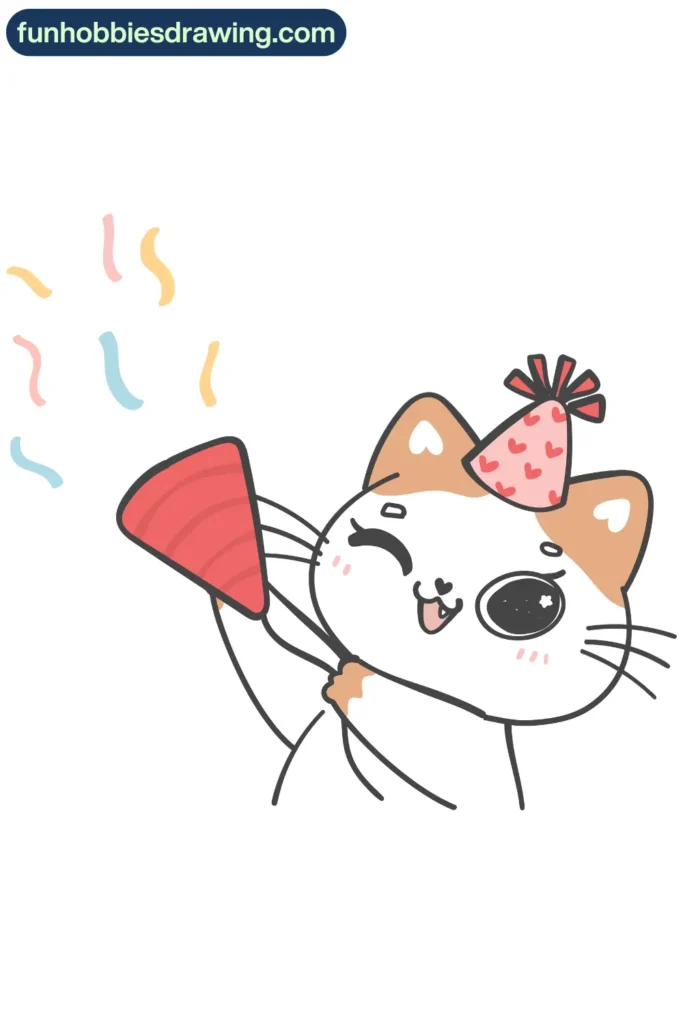
Cats are amazing creatures with unique personalities. They are perfect for creative character designs. You can create whimsical, cartoon-style cats or more realistic, human-like cats. Let your imagination run wild and bring your feline friends to life.
One way to design cat characters is by using big eyes and playful faces. Artists can make these cats look cute and cartoon-like. These feline-inspired cartoons are loved by many because they show the charm of cats.
If you prefer realism, you can focus on cat anatomy. Study the features of different breeds, like the Siamese or Persian. This way, you can create whimsical cat illustrations that show the beauty of cats. Adding human-like things like clothes can make these cats even more interesting.
The secret to great cat characters is knowing how cats behave. Try different styles and mediums to find what works best. Drawing from the world around you can open up many possibilities in cat character design.
7. Drawing Cats in Motion
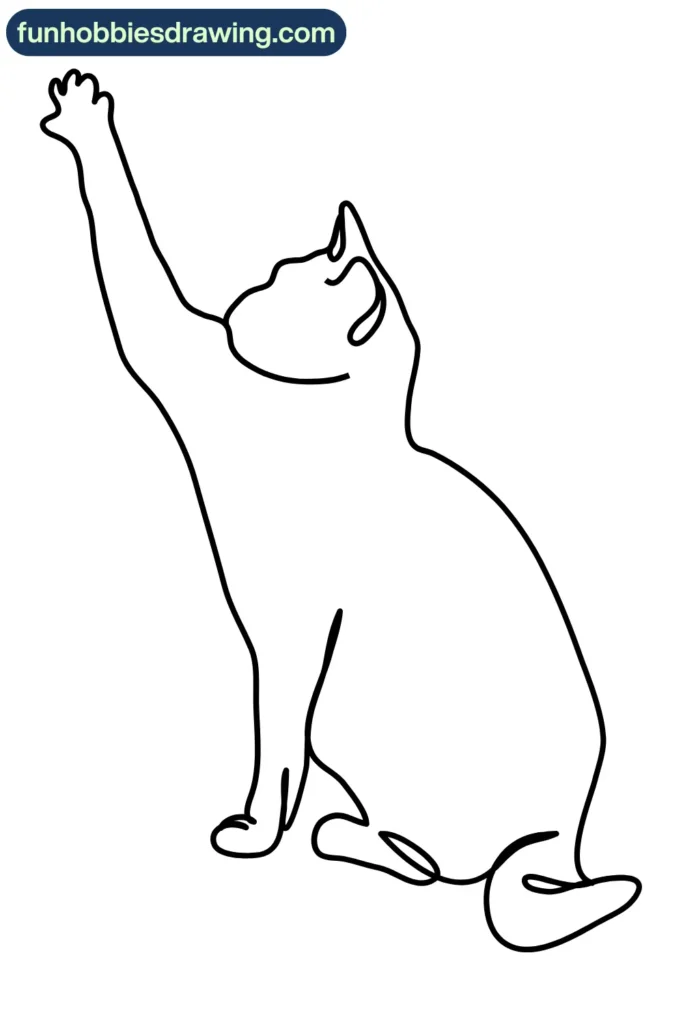
| Technique | Description |
|---|---|
| Gesture Drawing | Capturing a cat’s movement with quick, intuitive sketches that focus on form and energy. |
| Rough Outlines | Creating the basic structure and proportions of a cat’s body, then adding details and textures for a dynamic drawing. |
| Observational Sketching | Observing cats in their natural settings and drawing their movements and behaviors. |
Learning to draw cats in motion is a fun challenge for artists. Cats move with grace and agility. To capture these moments, you need a sharp eye and skilled hands.
Understanding a cat’s anatomy and movement is key. The hindquarters, spine, and paws are important for their poses. By studying these, you can show a cat’s energy and motion in your drawings.
Beverly Garland, a famous cat lover and artist, shares her tips on her YouTube channel “I Love to Draw Cats.” She teaches observing cats, breaking poses into simple shapes, and adding details for depth. Her methods help you master drawing cats in motion, dynamic cat sketches, and feline movement studies.
By learning these techniques, artists can capture the essence of cats in motion. It’s all about observing, experimenting, and loving the grace and power of cats. Whether you’re new or experienced, the journey is exciting and rewarding.
8. Realistic Cat Drawing
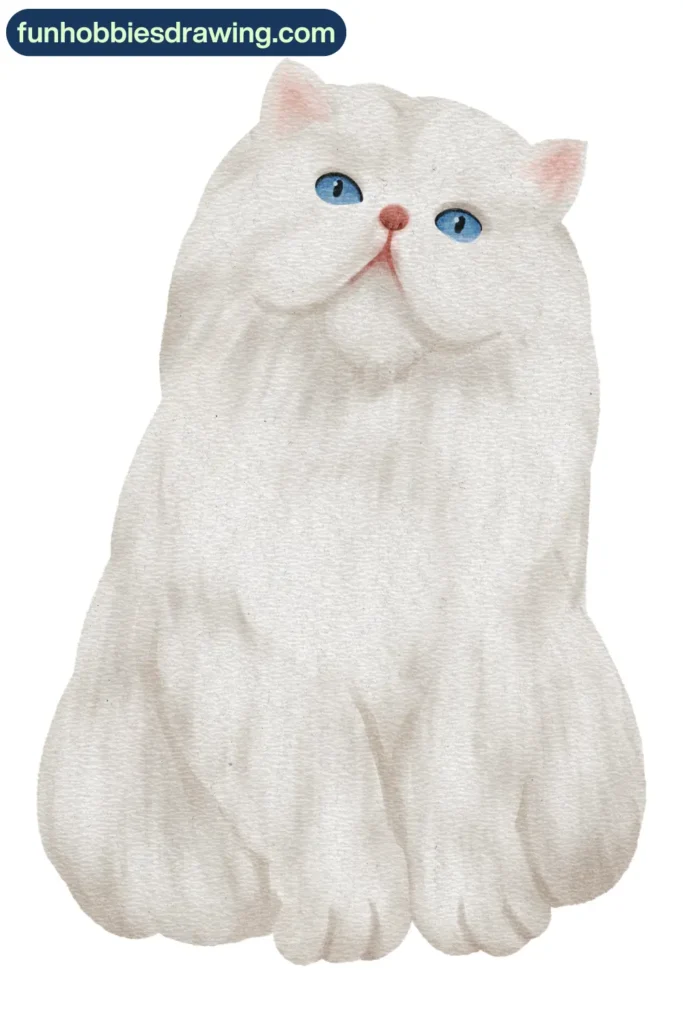
| Technique | Timeframe |
|---|---|
| Rendering the head | Longer than the body due to intricacies around eyes, nose, and ears |
| Completing the body | Usually a few hours, unless it’s a tabby cat, which can take significantly longer |
| Importance of contrast | Critical element to make drawings look realistic, with emphasis on bright white and deep black areas |
Making a realistic cat portrait needs a sharp eye, a steady hand, and a good grasp of cat anatomy. As an artist, I’ve learned that the secret to creating lifelike cat drawings is in the small details. From the fine whiskers to the deep eyes, each part must be drawn with care to show your cat’s true spirit.
One big challenge in drawing realistic cat portraits is getting the fur right. The texture and direction of each hair strand are key to the drawing’s realism. Observing a real cat’s fur patterns and colors helps a lot. It can take up to 8 hours just to get the eyes right, and the head often takes longer than the body to get all the details.
By focusing on the details of cat anatomy and the subtleties of their fur, I’ve made detailed, realistic cat portrait drawings that really show the cat’s personality. Whether you’re drawing from a photo or a live cat, mastering feline portraiture is a fulfilling journey. It lets you bring your detailed cat sketches to life.
9. Cat Doodle Drawing

Doodling is a fun, stress-free way to explore cat drawing ideas. It’s great for both seasoned artists and beginners. Adding feline elements to your doodles can spark your creativity and add whimsy to your work.
One of the best things about cat doodling is how simple it is. By using basic shapes, you can make cute sketches that show off your furry friends. A whopping 92% of people find simple cat doodles using Precision pens to be the most fun and easy.
Look at different cat doodle inspirations, from fun poses to abstract patterns. Online tutorials on cat doodling have seen an 86% increase in searches for step-by-step guides in the last year. Use these easy prompts to make your doodle art better and add a feline touch to your sketchbook or bullet journal.
Whether you’re doodling in a B5 journal or trying out Faber Castell fineliners and Zebra Mildliners, the key is to have fun. Remember, doodle art is all about simplicity. So, let your imagination run wild and create your own unique simple cat sketches.
10. Kawaii Cat Drawing
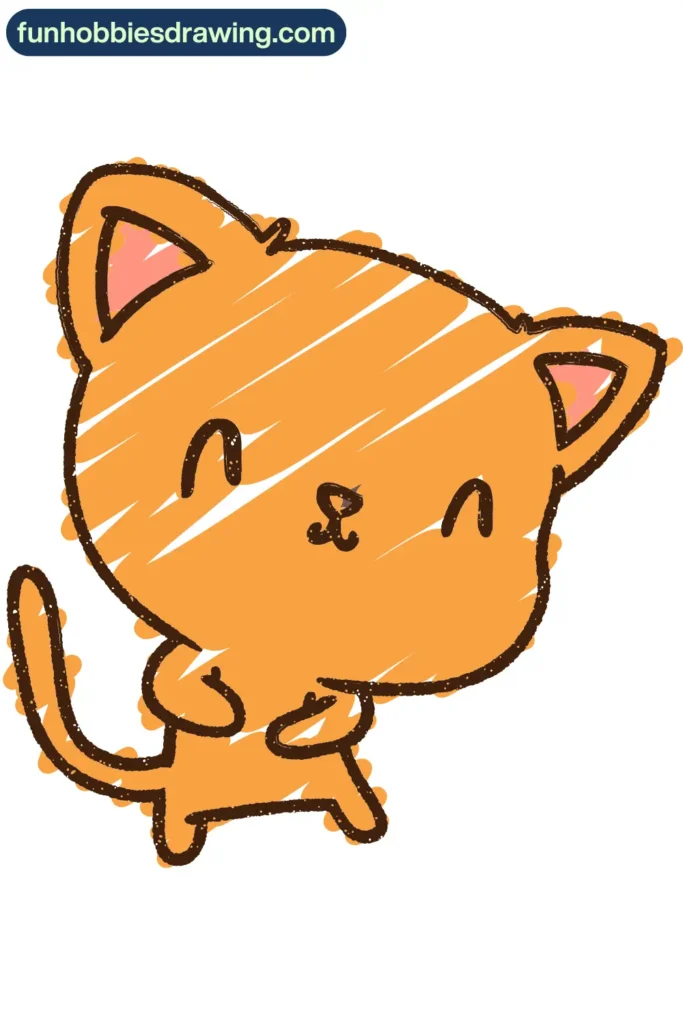
Kawaii art is all about cute and whimsical. It’s a fun way to draw cats. You’ll learn how to make kawaii cat art ideas that are both cute and full of life.
This collection has 27 cute cat sketches for all skill levels. You’ll see cats in different poses and moods. From real to cartoon-like, these easy cartoon cat drawings will help you grow.
To start, draw your cat in pencil. Then, use a pen to fill in the lines. Erase the pencil to see your ink drawing. Keep practicing to get better, and don’t worry about making mistakes.
Imagine cats in fun places like cardboard boxes or on clouds. These cute cat sketches will help you show off your creativity. They mix real and stylized to improve your skills.
So, pick up your sketchbook and start drawing. Make kawaii cat art ideas that will make everyone smile. The fun of learning is just as important as the art itself.
11. Cat Anatomy Drawing
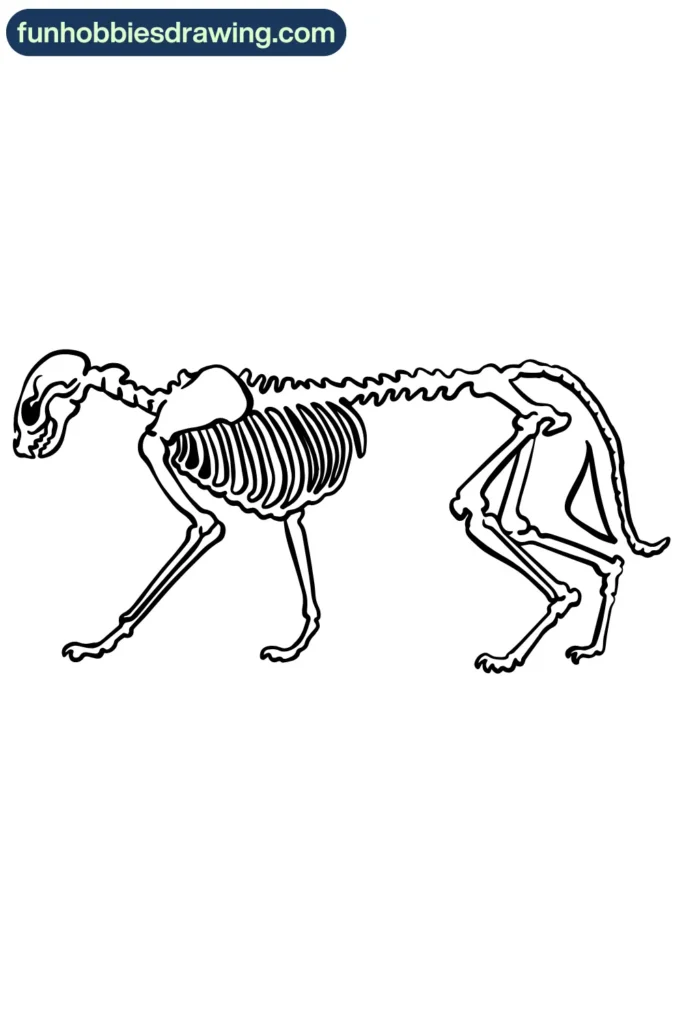
Learning about cat anatomy can make your drawings more accurate and realistic. By understanding the basics of feline anatomy, you can create more lifelike cat sketches. This section will cover the key parts of a cat’s body, face, and proportions. It will help you improve your cat anatomy drawing skills.
Understanding a cat’s skeletal and muscular systems is key to better drawings. Knowing the spine, ribcage, and limb structures helps show the cat’s form and movements. Also, learning about the major muscles lets you show a cat’s poses and gestures.
Looking into the details of a cat’s face can make your drawings more realistic and full of character. Paying attention to the eyes, nose, ears, and whiskers helps capture a cat’s personality and emotions. Mastering these details will make your cat drawings more captivating and lifelike.
Exploring Different Mediums for Cat Drawings
| Medium | Unique Properties | Suggested Cat Drawing Ideas |
|---|---|---|
| Pencil | Precise, Versatile, Allows for Detailed Shading | Realistic Cat Portraits, Anatomical Studies, Detailed Feline Sketches |
| Watercolor | Vibrant Colors, Fluid Brushstrokes, Spontaneous Blending | Whimsical Cat Scenes, Expressive Cat Illustrations, Watercolor Cat Paintings |
| Pastel | Soft, Blendable Textures, Vibrant Pigments | Textural Cat Portraits, Atmospheric Cat Landscapes, Pastel Cat Drawings |
| Markers | Bold, Saturated Colors, Precise Line Work | Dynamic Cat Expressions, Graphic Cat Illustrations, Marker-Based Cat Sketches |
| Digital Tools | Unlimited Layers, Versatile Brushes, Editing Capabilities | Conceptual Cat Designs, Digitally Painted Cat Portraits, Cat Character Designs |
As a cat artist, trying out different mediums can open up a world of creative possibilities. From pencils and paints to pastels, markers, and digital tools, each has its own special touch. This can make your cat drawings come alive in new ways.
Get creative by trying out many art materials. See how chalk-style painting can capture a cat’s playful spirit. Or, how pastel can show off a cat’s soft coat. Try watercolor for vibrant cat portraits or calligraphy ink for detailed sketches.
Using a variety of mediums can lead to cat drawing with different mediums, mixed media cat art, and creative cat sketches. Each method brings its own challenges and rewards. It lets you find your own style and bring your feline inspirations to life in new ways.
Explore the many mediums and let your feline inspirations guide you. Discover the special qualities of each material. See how they can make your cat-themed artwork even better, opening up a world of endless creativity.
